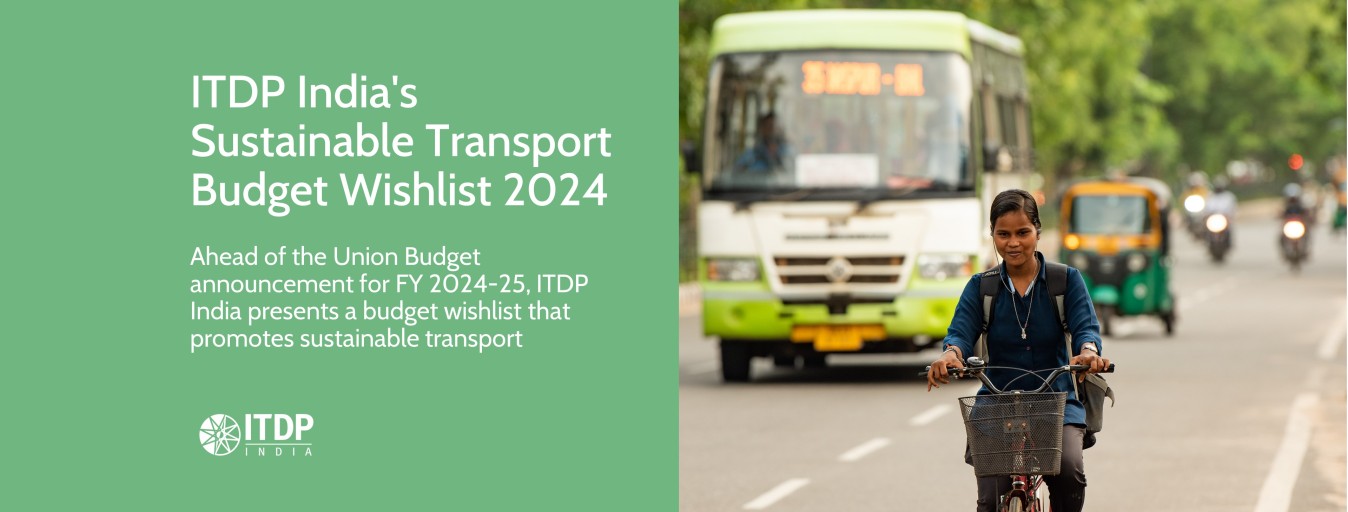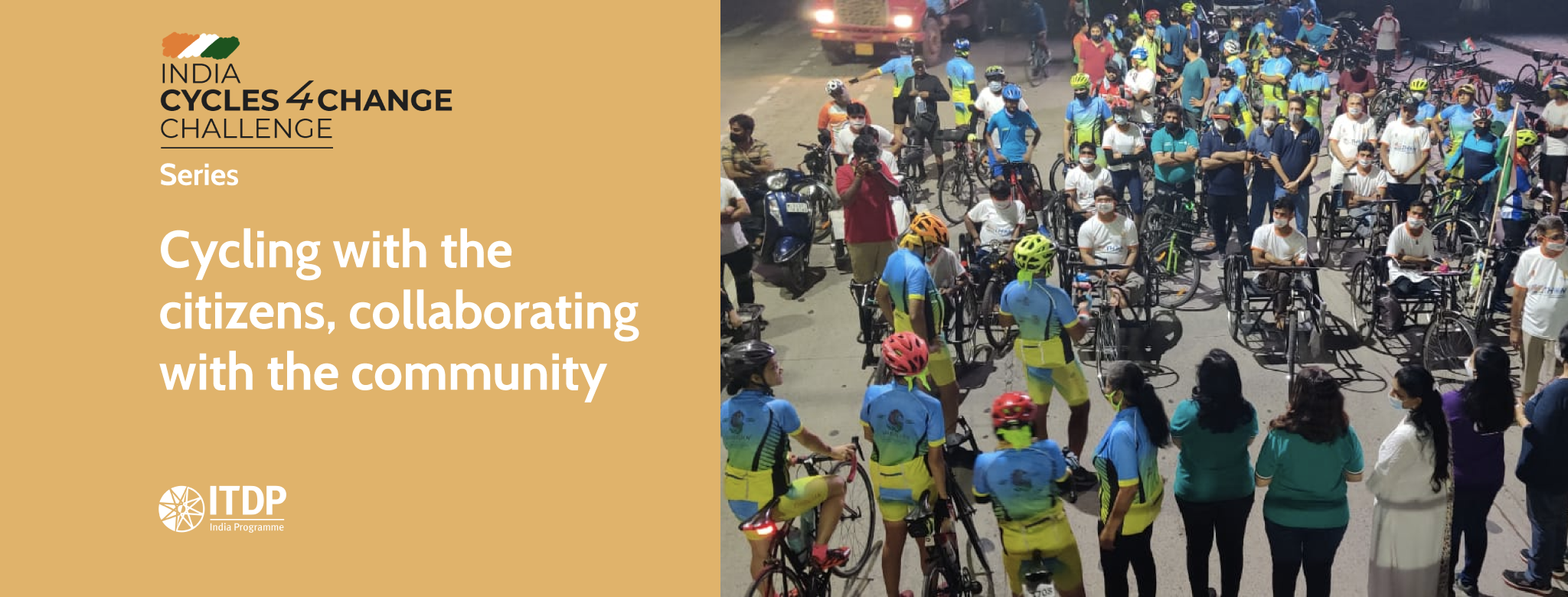As the Finance Minister of India prepares to announce the new budget for the country shortly, our diverse team has brainstormed a list of budgetary interventions we wish to see in the upcoming budget and beyond.
In a post-pandemic world, as our cities grow more rapidly than ever, facing various climate change impacts, our wishlist aims to put ‘sustainability’ at the forefront of our transport and urban policies. Here is a list of five action areas where we seek to see increased focus and budget prioritisation.
1. Ensuring allocation of Transport Budgets towards Sustainable Mobility
What we want: At least 50-60% of the total transport budget to be allocated for sustainable mobility projects including public bus transport, e-buses, walking, cycling, micro-mobility, e-shared passenger and freight across Indian cities.
Why: As per 2011 Census, nearly 72% of trips in India are on foot, cycle, and public transport. It is only fair that the transport budget reflects this proportion, ensuring that sustainable transport receives the attention and funding it deserves.
2. Prioritising More Buses, Better Buses, Greener Buses
What we want: A 15-fold scale-up of national programs like the PM E-Bus Sewa Scheme to ensure More Buses, Better Buses, and Green Buses in all cities with financial support. Financial support should be provided to public bus operators in the form of viability gap funding on Gross Cost Contracts (GCC).
Electrification of private sector buses, which make up for 93% of buses in India, presents an opportunity for reducing emissions that can be facilitated through lower interest rates for loans, longer loan tenure, and a leasing model.
Why: Public and private bus transport forms the backbone of Indian transportation, catering to 30 crore daily passenger trips. It is crucial to improve both the quality and quantity of both the public and private buses through prioritised investments in better and greener options.
With ~20 lakh public and private buses in India. Even if just one-fifth of these buses go electric, it could reduce 85 lakh tonnes of CO2 emissions per year– helping India achieve its 2070 Net Zero vision.
3.Creating Walking and Cycling Friendly Indian cities
What we want: Specific budgetary allocation and a national commitment towards creating walking and cycling-friendly streets across Indian cities. All states should be guided towards adopting state-level street design guidelines, policies, and action plans. These must be followed when taking up upgradation or street development work.
Why: A robust walking and cycling infrastructure provide a highly cost-effective means of mitigating greenhouse gas emissions, improving public health, saving money for residents, increasing access to opportunities and improving public safety in cities. For this very reason, world over attempt is being made to increase walking and cycling. But in India, already 48% of the population commutes by walking or cycling, as per Census 2011. This goes to show that we have a strong demand for walking and cycling.
Despite the clear and significant benefits that investments in walking & cycling infrastructure bring to pedestrians, cyclists, and society at large, this is not adequately reflected in the transport budgets or actions of national, state, and city agencies. The lack of prioritisation for safe walking and cycling infrastructure has been a persistent issue across Indian cities and should be a key focus moving forward.
4.Connecting the Dots: Seamless Integration
What we want: Budget allocation for cities with ongoing and upcoming metro projects to ensure seamless physical, information, and fare integration. The integration should be based on the local area plans, between different modes of transportation including bus, metro, suburban rail, walk, and cycle within a 500m radius of any station area, to encourage a modal shift to sustainable modes of transport.
Why: Seamless integration plays a crucial role in making people shift to sustainable transport. The journey must be convenient, seamless, and connected right from planning, boarding, alighting, payments etc. Unless these are integrated, private vehicle users may not shift to sustainable transport modes.
5. Pricing Pollution
What we want: Provide policy, technical, and budgetary support to states and cities towards adopting parking policies, implementing parking management measures, and setting up low emission zones with a mobility component. These measures can discourage the use of polluting vehicles through pricing and reduce traffic congestion. The national government could encourage cities to develop newer revenue sources by pricing parking and polluting vehicles.
Why: As per the World Air Quality Report 2023, India is the third most polluted country in the world. Several Indian cities like Delhi, feature in the infamous list of most polluted places in the world. There is an urgent need for separate budget allocation to implement strategies that tackle vehicular pollution and congestion which can lead to lower costs related to road maintenance, healthcare, and fuel consumption.
Cities can also generate new revenue sources by pricing parking and implementing charges for polluting vehicles. This revenue can be reinvested in sustainable urban mobility projects.
But how can these be effectively rolled out ensuring accountability for cities? Well, here are some suggestions:
a. Set up a National Sustainable Mobility Mission, empowered to allocate funds under an Urban Transport Fund, monitor projects, and fastrack sustainability mobility projects across state/cities.
b. Adopt a result-oriented approach for every project undertaken via the National Sustainable Mobility Mission. For every project, a framework is to be adopted, and budget should be specifically allocated within project costs for ‘Impact assessment of infrastructure’ and performance audit of programs to ensure public money is spent wisely benefitting large masses.
c. Empower those cities that have an operational Unified Metropolitan Transport Authority (UMTA) or a Green Mobility Cell to avail the budgetary support from the national mission. These entities should be empowered legally and financially to facilitate coordination, planning, and execution of sustainable transport initiatives among various agencies.
d. Set up a Green Mobility Data Centre for data-driven decision-making. These data-centres can collect granular and gender-disaggregated mobility data, analyse the same. The collected data can be used for planning, design, budgeting, management, enforcement, and performance evaluation of all mobility interventions and initiatives.
e. Empower the states and cities to revise existing Motor Vehicle Acts, Municipal and District Acts with rules for prioritising pedestrian-friendly infrastructure to avail the budgetary support. Cities will have to ensure that all upgraded or newly laid out street development will be completed with the provision of safe, continuous, and comfortable pedestrian infrastructure as per the national street design guidelines.
f. Create a national platform for technical experts who can especially support Tier 2 and Tier 3 cities in piloting and scaling up infrastructure projects. This will ensure high quality planning, design, and implementation of the projects across India.
g. Mandate state and city transport to make allocations in transport budgets that benefit women, gender minorities, and vulnerable users. It’s enforcement can be done by setting up Inclusive Mobility Committee and/or Inclusion officers. Initiatives such as women-led transport cooperatives for ride sharing services, measures to ensure travel safety, training for these users in roles like drivers, mechanics and engineers should be explored
As we began compiling our wish list, we realised that what we truly desire is a return to prioritising the basics. We seek strong national commitment to fulfil the 2030 sustainable mobility vision for India, where all cities have:
A– Accessible and safe streets for all.
B– Buses near everyone, everywhere, on time.
C– Congestion and pollution free cities.
Written by
Team ITDP India




















